#Lucern bug
Explore tagged Tumblr posts
Photo
Beautiful! I'd put it on my desktop if it weren't vertical.

Green bug by andredekesel https://flic.kr/p/2o4Ljbx
#andre de kesel#insect#bug#lucerne bug#adelphocoris lineolatus#vegetation#flower#cornflower#centaurea cyanus#nature
12 notes
·
View notes
Text

Underground Tavern Bug Fables OC Collab [5/26]
Background - @flame-shadow
Character Credits:
Zelkova - @nquill
Lucerne - @sappedart
Polista & Callisto - @trapitorag & Hambreezy
Vinny & Kayfer - @minersjob & @bakingtheraw
Kurtis - @bakingtheraw
Absinthe - @sappedart
Murmur - @sappedart
Bombus - @trapitorag
32 notes
·
View notes
Note
Could you rank the most intelligent to least intelligent performance breeds you’ve ever dealt with?
As well as the most to least affectionate Show breeds?

If you consider the Feral a breed in itself, it is, hands down, the most intelligent.
They are the product of generations of birds living without human care, who have had to dodge predators and scrounge what food they can, surviving on their wits alone and passing their knowledge to each successive generation.
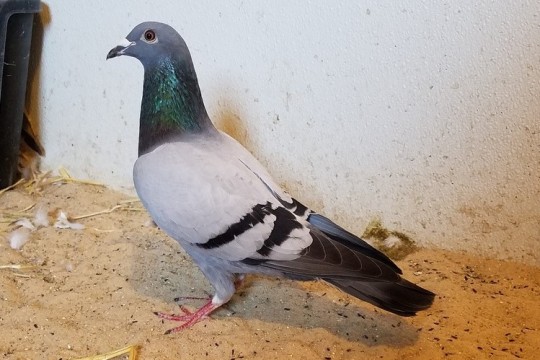
If you do not consider Ferals to be a breed, then the Racing Homer is the most intelligent performer.
They have safe nests and thrive in human care, if and only if they succeed at dodging predators and finding their way home over trips up to 500 miles away, which can take days, through any kind of weather.
Those that do not succeed are lucky to survive. Most fall prey to hawks, vehicles, and exhaustion.
Those very lucky few who do live long enough to be found are the vast majority of rescues in most places, typically outnumbering even ferals and utility kings, especially in the fall.
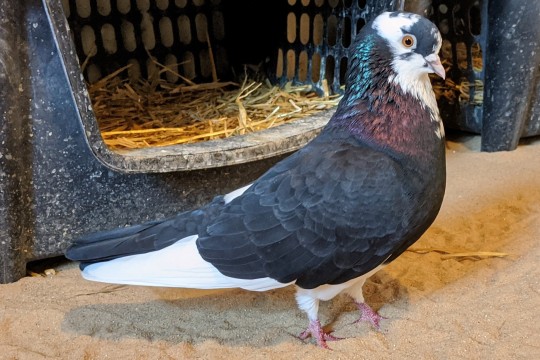
Birmingham Rollers
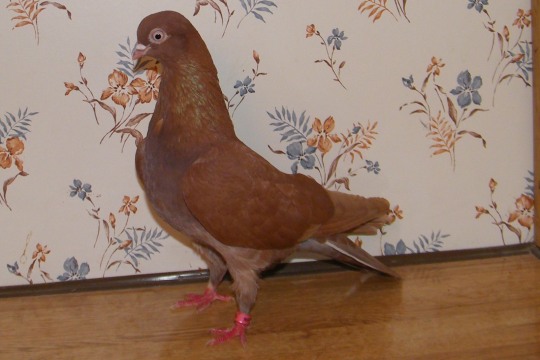
and Portuguese Tumblers
Only have to dodge predators in short flights above their lofts.
Both breeds are trained to fly in a team called a Kit, required to be extremely biddable by their trainer, who acts in part as their predator spotter and calls them in either at the end of a performance, or when a predator is sighted.
Biddability requires intelligence, but not nearly as much as the independent decision making capability by which Homers navigate and ferals survive.
These are the four performers I have the most hands on experience with.
I can't really report on birds I have not worked with many of.
As to the exhibition breeds:
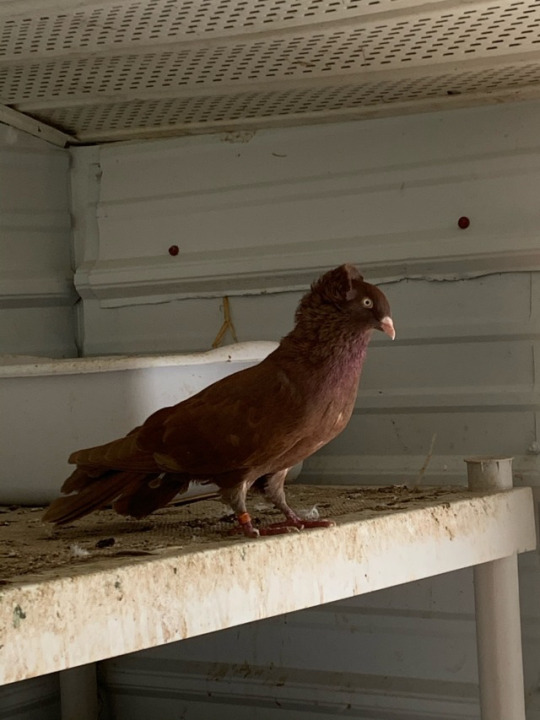
This bird does not belong to me.
He is Cotta's great Grandsire.
But I have to list the Show Line Danzig Highflier as the single most affectionate exhibition breed for the rock solid, determinedly sweet temperament that has passed down to all of his descendants, regardless of what they were mixed with for four straight generations.
When socialized with humans, they are the loviest things you can lay hands on shy of an imprint.
They are even one of the very rare relatively low dust breeds, though I am not sure exactly how that inherits.
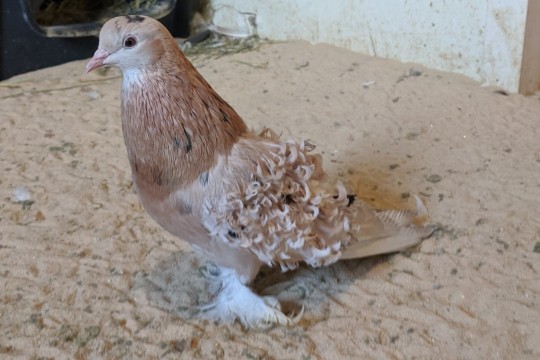
Frillbacks
This breed is an entire loaf of bread.
They are extremely mellow, and not because they are stupid or flight is difficult or painful.
Most of them that I have socialized have sought out my lap as the most comfortable place to loaf, and will loaf with a person they like for hours.
This exceptionally sweet temperament passes reliably to their offspring.
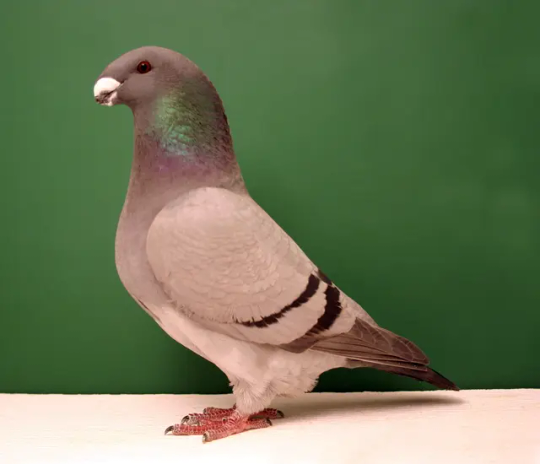
Once again, this is not my bird.
But I have to rank the American Show Racer very high because of the reliability with which the breed's unflappably mellow temperament has passed to its decedents in my experience thus far.
This is an unshakable brick of a bird, that, when socialized, is very tractable and docile.
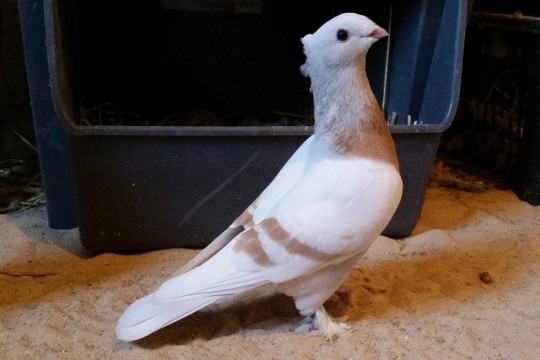
Lucerne
Extremely docile, but ranked lower because even birds that out right disliked me were very tolerant and relaxed in the hand.
There is a huge difference between docile/tolerant and affectionate, and affectionate is what I want.
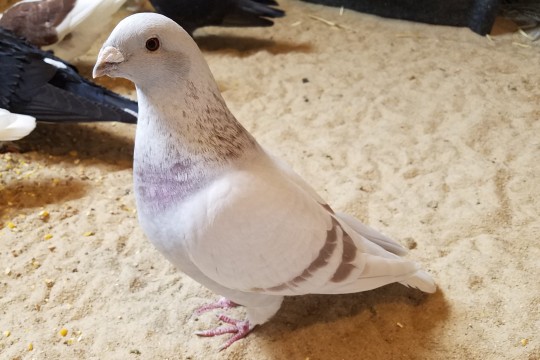
Show Type Racing Homer
Very mellow baseline temperament, but not necessarily inclined to be a friendly bird.
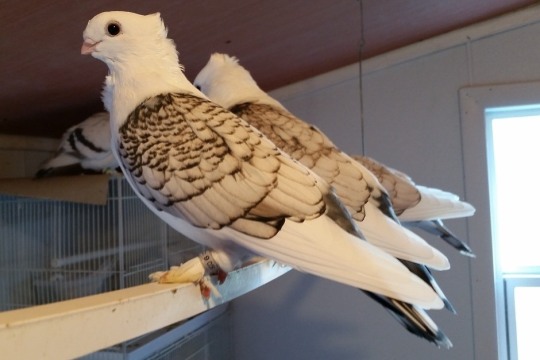
Classic Old Frill
I love this breed dearly.
But I have to place them here because their temperament is very hit or miss.
Depending on how they are socialized, you will either have a doting cuddle bug, or an extremely skittish bird that wants nothing to do with you.
I have had an even mix of both result when I bred them for show, and birds that largely ignored me also came to be, but those were rarer than either cuddle bugs or skittish.
Those that do end up being cuddle bugs? The single most affectionate seekers of human company I have ever had the pleasure of handling!
That's all six I will be using for temperament.
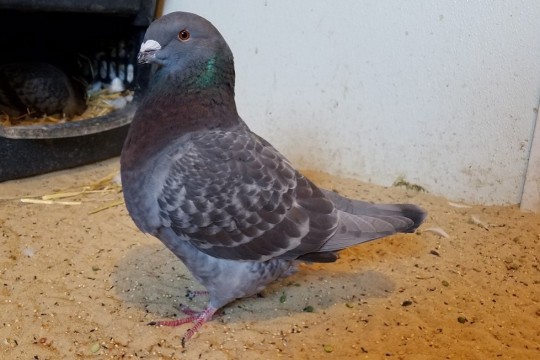
Giant Homer
An absolute bowling ball of a bird, so when I call them the biggest cuddle bug, I mean that literally.
This was, initially, a Utility breed, meaning they were bred for meat.
As with most meat animals, like Flemish and Continental Giant bunnies, that means that these birds are two things; extremely heavy and extremely docile.
But because of the shift from meat bird to show bird by people who liked the big round aesthetic, part of that docility is their natural temperament, but as with boiler chickens, a lot of it is from simply being too heavy to comfortably move.
These are prone to a lot of uncomfortable health issues, from hyper rapid growth of calluses on the soles of their feet to feather deformities. (Both Bertha and Agnes suffered from abscessed flights that grew in upside down and backwards and couldn't break skin that was not supposed to have closed over the follicle.)
They do not like to move because frankly, their feet and wings tend to hurt, so they will gladly seek out a soft, warm lap to sit on.
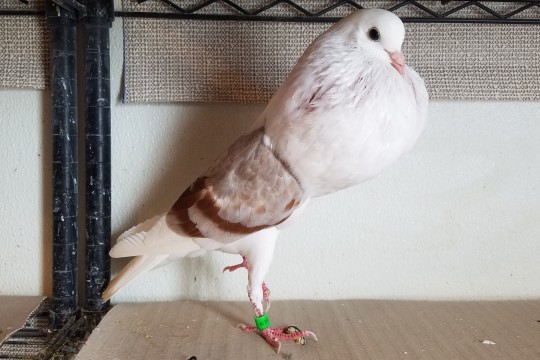
Voorburg Shield Croppers
Are the only breed I know of with a temperament requirement written into their breed standard.
They are required to blow and dance to woo the judges, but this is not so much friendly as horny behavior, making this particular breed more inclined to see humans as potential mates regardless of imprinting.
When blended with other breeds, it leads to very pushy, aggressively forward cocks that absolutely will not take no for an answer and will fight you to the gates of hell about it.
This behavior is not particularly unpleasant in pure Voorburgs because their inflated globe is not a physical trait, but a genetically coded behavior. (Fascinatingly, passed on by a dominant gene).
Basically, they are compelled to keep their globe inflated most of the time, and that compulsion is stronger than the typical compulsion of a pigeon cock to bite to initiate the driving phase of courtship.
They can't hold their beaks open to bite without deflating their globe, and even if they could, the globe inflates far wider than the beak is long.
So, where an aggressively amorous cock of any other breed will charge in a bite, Voorburgs charge in and boop into you with their soft inflated globe.
They are harmless and adorable as they are, but that genetic drive to determinedly court humans is why I will not be incorporating any more into the project.

Valencian Figurita
These have mostly been very sweet in my experience, though that is largely dependent on bloodline.
I have lucked out with most of them so far, and their offspring tend to inherit a very demure, sweet temper.
I have stopped working with them because they are so tiny that they often need at least one of their young to be fostered under other similar sized birds like Ringneck Doves.
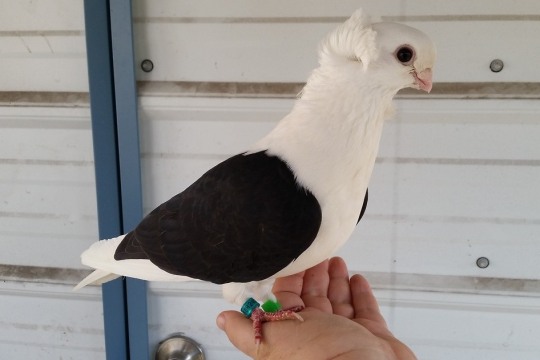
Old German Owl
I have met some absolutely wonderful OGO.
But the vast majority have been fairly skittish, and so have their offspring with other breeds.
Temperament is mostly genetic in pigeons. Flightiness, for example, is a single dominant gene.
It's hell to breed out because it isn't visible and can be overcome by high intelligence.
But exhibition breeds tend to be pretty low intelligence, simply because there is so much less need of it when you exist to look pretty in a show pen.
If you can, try to meet the breeder in person and see how their birds react to them.
Astrid's dearly loved her, and she was extremely sweet tempered. A far cry from OGO I had purchased at shows.
Her children were very sweet tempered too.
So don't count them out, just research the breeder.
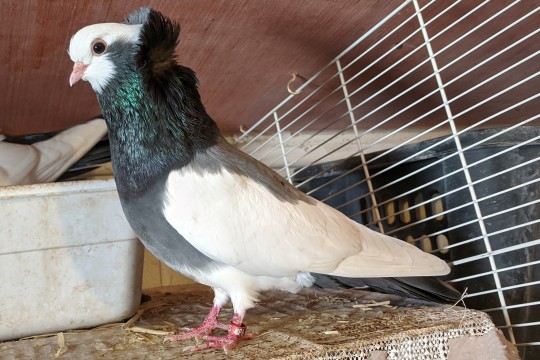
Komorner Tumbler
This is no longer a flying breed, and as such it has lost quite a lot of its intelligence.
That said, it has lost a lot of flightiness too!
These have a good probability of being fairly sweet and happy to seek out human attention.
If you don't mind the bird not being very bright, a Komorner might be an ok fit for some one looking for a bird that's easy to socialize.

Nun
Nuns, on the other hand, are almost notorious for having lost almost all survival instinct.
Oh, they're sweet as they can be, but described as being too stupid to move out from underfoot or recognize their own eggs as something other than a weirdly hard poop.
They are often fostered under other breeds because they will poop an egg on the floor, if it's lucky, and just walk away.

Chinese Owl
I have heard that these are docile, but that has been absolutely none of my experience with them!
Flightiness is a dominant gene, and these nervous messes have made skittish terrors of nearly everything they have mixed with in my care.
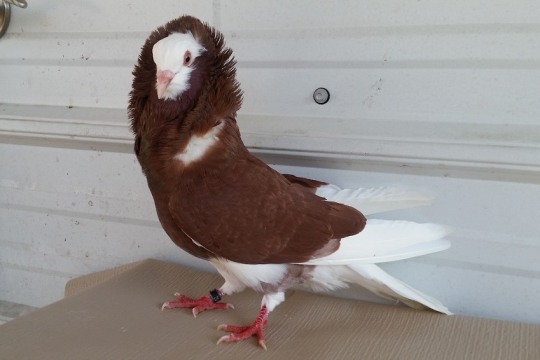
Same goes for the striking Old Dutch Capuchin.
I have decided to remove these from the list of breeds I intend to blend simply because their unique embellishment is not enough to balance out their high strung skittishness.
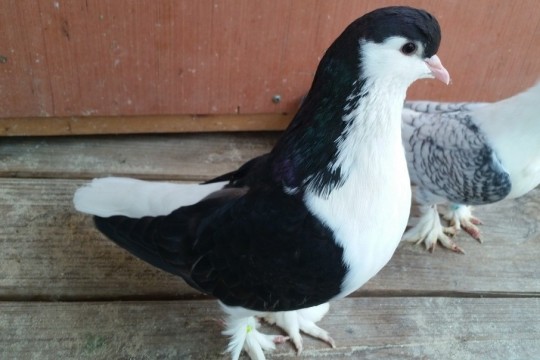
Lahore
These lovely anime penguin cosplayers are not by any means skittish!
While you will get sweet individuals on occasion, typically cocks, the hens will fight God!
They are a lot less inclined to be combative with other pigeons as they are to be with you, but if you get one that likes you, she will fight god over the right to be in contact with you!
While I have had a Mindian, American, and Garden fantail, I do not have enough hands on experience with these breeds to evaluate them fairly for this question.
The Garden fantail is the only breed I plan to incorporate primarily for its structural embellishments, rather than temperament or intelligence.
48 notes
·
View notes
Note
3, 14 & 20?
the questions
3. when do you wake up?
I'd like to be able to give you a different answer but right now it's around 11am or so. Usually (or maybe just aspirationally) it's more like 9. When I had a regular job for a few years I had to wake up at around 7 or so and I think it permanently damaged my body and brain.
14. what is your defining personality trait?
I already answered this, but I'll give another candidate trait. I am a very guilty person. Guilt is sticky to me. One of my earliest memories is being afraid of a (completely harmless) bug and stomping on it with my foot, and then looking at the bloody stain on the concrete and screaming in sadness that I'd killed something. I still remember that. What's really insane is that I don't even think I can say that I feel zero guilt over it right now. I think this is derivative of being very sensitive to the very idea of suffering and wronging in the world. Being responsible for any portion of it is hard to bear.
20. weapon of choice in a medieval battle
Weird juxtaposition with the last answer but I'm going with the Lucerne hammer because I dig a hammer and I dig a spear and this is sort of the best of both worlds. And it's pretty.
3 notes
·
View notes
Photo

Lucernetæge (Adelphocoris lineolatus)
Fouragerer på rejnfan (Tanacetum vulgarins)
Lucerne bug (Adelphocoris lineolatus)
Foraging on Tansy (Tanacetum vulgaris)
#Lucernetæge#Adelphocoris lineolatus#Adelphocoris#Lucern bug#tæge#blomstertæge#bug#insekt#insect#plante#plant#tansy#rejnfan#Tanacetum vulgaris#Sommer#Summer#Blåbærhøj
1 note
·
View note
Photo










Lucerne (pt2)
2 notes
·
View notes
Text
CROPS, POLLINATION, FOOD: WHY WE NEED BEES
33% of the world's yields need fertilization to set seeds and natural products, and a dominant part of them are pollinated by honey bees. Alongside different pollinators, honey bees are as of now endangered by human action. There is a worldwide decrease in the honey bee population, because of reasons like over the top utilization of bug sprays, living space misfortune, natural surroundings fracture, honey bee irritations and illnesses, and environmental change.
So as to bring issues to light about their basic job in supportable turn of events, the United Nations has proclaimed May 20 as World Bee Day.
There are almost 25,000 types of honey bees: 70-80% of the world's yields/plants are pollinated by wild honey bees while 15-20% are pollinated by honeybees. These pollinators additionally give a significant biological system administration that is basic for supporting the wild greenery biodiversity. For instance, if there should arise an occurrence of pigeonpea, Apis mellifera, A. dorsata, An indica (Pathak, 1970), Megachile spp. (Williams, 1977; Zeng-Hong et al. 2011), and Xylocopa spp. (Onim, 1981) are significant sources of normal cross-pollination.
Impact of honey bee fertilization on crop
It builds seed yield and natural product yield in numerous harvests.
It improves the nature of foods grown from the ground.
Honey bee pollination builds the oil substance of seeds in a sunflower.
Honey bee pollination is an unquestionable requirement in some self-incongruent yields for seed set.
Crops profited by honey bee pollination
Leafy foods, apple, apricot, peach, strawberry, citrus and litchi
Vegetable and Vegetable seed crops: Cabbage, cauliflower, carrot, coriander, cucumber, melon, onion, pumpkin, radish and turnip
Oilseed crops: Sunflower, niger, rapeseed, mustard, safflower, gingelly.
Search seed crops: Lucerne, clover
Developed field crops: Pigeonpea, lentils, clovers, Lucerne, mustard, assault, linseed, sesame, gingelly, buck-wheat, Cambodia, safflower, millet, and sunflower
Lumber trees: Neem, Cassia fistula, Acacia, Albizzia, Kachnar (Bauhinia purpurea), eucalyptus, sandalwood, raintree, wild cherry
Regular and decorative blossoms: Cosmos, shoe bloom, brilliant bar, cup and saucer, Tecoma stans, zinnia,
coral creeper (Antigonon leptopus), rose, Rangoon creeper, aster, wild rose (Kuja), hydrangea, violet, portulaca, poinsettia, honeysuckle, cornflower, coreopsis, dandelion and so forth.
What we should do:
Change to eco-accommodating pesticides
Limit intensive agriculture
Keep up normal natural surroundings inside a agriculture mosaic
1 note
·
View note
Text
The End has Begun
World organization has collapsed, and the only rule of law is that of strength. The dead walk the streets, mindless corpses that feel nothing but an incessant hunger. The world as you know it has died, and you need to be certain that you don’t follow. You need to defend yourself. Somehow, you’ve managed to find yourself in an arsenal, massive and seemingly unending. Every sort of personal weapon imaginable sits on the walls, ancient to modern. Trouble is, you’re but one person. What do you choose?
The zombie apocalypse, an ever popular point of discussion amongst many groups of people in today’s world. Where would you go? What’s your bug out plan? Would you trust others, and try to rebuild, or go it alone? All popular questions when plumbing the depths of the hypothetical, but as an arms and armor enthusiast, I’m drawn to a different set of questions, namely: what weapons would be best for fighting zombies?
Before we begin exploring this question in depth, certain questions must be answered. Zombies vary greatly depending on what media they appear in, so some parameters must be set before we can determine what weapons would be useful.
I’ve always been personally enamoured of the idea of a virus, one that shuts down the higher functions of the brain and reduces the individual to a slavering beast that hungers for flesh. In this scenario, a zombie would work like any other living thing, minus intelligence and the effects of pain. Cut off its arm, and it will bleed to death, but keep coming for you.
This isn’t how most zombies tend to work though, so we’ll add something on top of it. For some reason, zombies can only be killed by a blow directly to the heart, or to the brain. Any other kinds of wounds or dismemberments will leave the creature alive and still coming (though taking off its legs may leave it somewhat slower.)
Equally, we will maintain that this virus is transmitted through bodily fluids only. Primarily of course, this means saliva, although blood will also play a factor. The zombie’s hands, while still capable of grabbing and scratching, pose no threat by way of virus transference.
Finally, we will assume that the dead move at a slow shamble, and a slightly quicker limping jog if provoked. The virus also halts decomposition, so a zombie can “live” until it is killed by some means.
Having established what sorts of undead we’ll be dealing with, the weapons that will be useful can be sussed out. A good place to start out is with guns. Guns, taken as a lump category, feature heavily in zombie games and movies, and it’s easy to see why. They have a lot of advantages over other sorts of weaponry, including range and rate of fire, and this is why they are the primary weapons in the world today.
Guns also come with a number of disadvantages however, which would be exacerbated by the survival situation of an apocalypse. One of the most obvious is noise. Assuming that zombies are smart enough to be drawn to the sounds of gunfire, your one, easily taken care of zombie may quickly turn into a much larger number. Ammo is also a difficulty for a number of reasons. First, it is difficult to manufacture, and takes knowledge very few alive today possess. Equally, ammunition is deceptively heavy, and if facing very large numbers, the limited ammo you would want to carry to keep weight low may soon run out.
Of course, keeping zombies at a distance is always a good idea, this way you stand no risk of being infected, so what alternatives do you have? Well, bows and crossbows of course.
Now, while these archaic weapons have no place on the modern battlefield, they would likely prove invaluable in an apocalyptic setting. They have the advantage of being markedly more silent than any firearm, especially in the case of the bow, and ammunition is much simpler to manufacture. Crossbow bolts and arrows can be fashioned from a simple stick, sharpened to a point, and some feathers fastened to it with pitch glue or sinew. Stone tips can be made (with significant practice,) and both of these weapons can be made in a wilderness survival situation if one simply knows how (though this is much more true with the bow.)
Both of these weapons take more skill to use effectively than a firearm however, especially the bow. The bow does, however, have a much greater rate of fire than the crossbow, so it is give an take. Another thing to consider is bulk. Crossbows are much bulkier than bows, though bows are quite long, and both are beasts to deal with when compared to handguns, which can be carried quite easily.
However, there will always come a time when ammo runs short, or the enemy is too close and too numerous for projectiles to be efficient. This is where we come to the fun ones, the melee weapons.
Of course, we established that keeping the dead at a distance is ideal, and zombies, given that they aren’t prone to using weapons, only have the reach of their arms, so polearms come to mind as an efficient way to strike zombies in melee from a safe distance.
This is where a very important distinction will come into play. The cut versus the thrust. Each has its advantages and disadvantages when it comes to fighting humans, but when it comes to zombies, it is my firm belief that the cut is the way to go.

A thrust is more likely to glance off a hard surface (like a skull,) and also requires much more accuracy to be effective, especially against a target such as a zombie, on which the vitals are limited. Equally, If a thrust makes to land to the heart, or penetrate the skull and enter the brain, the zombie will be killed, however if it lands anywhere else on the body, the creature will be unaffected. A cut that lands on the neck can sever the head. Limbs can be cut off, limiting the creature’s effectiveness, and it has been shown time and again the cuts have the capability of shearing through a skull completely (pictured above.)
Bludgeoning impact would also be immensely effective if directed at the zombie’s head. A sufficient blunt impact easily has the capability of crushing the skull, and damaging the brain enough to kill the undead.
All of these conclusions lead us to a certain few categories of polearm. The more thrust-centric polearms would be less useful, so things like the spear, pike, partian, or fork are right out. Often, shorter is better, simply because the weapon needs to be handled daily and a longer shaft is more cumbersome. Equally, it doesn’t really matter how far out of the zombie’s reach you are, so long as it can’t hurt you.
Two polearms come to mind as ideal. The poleaxe,
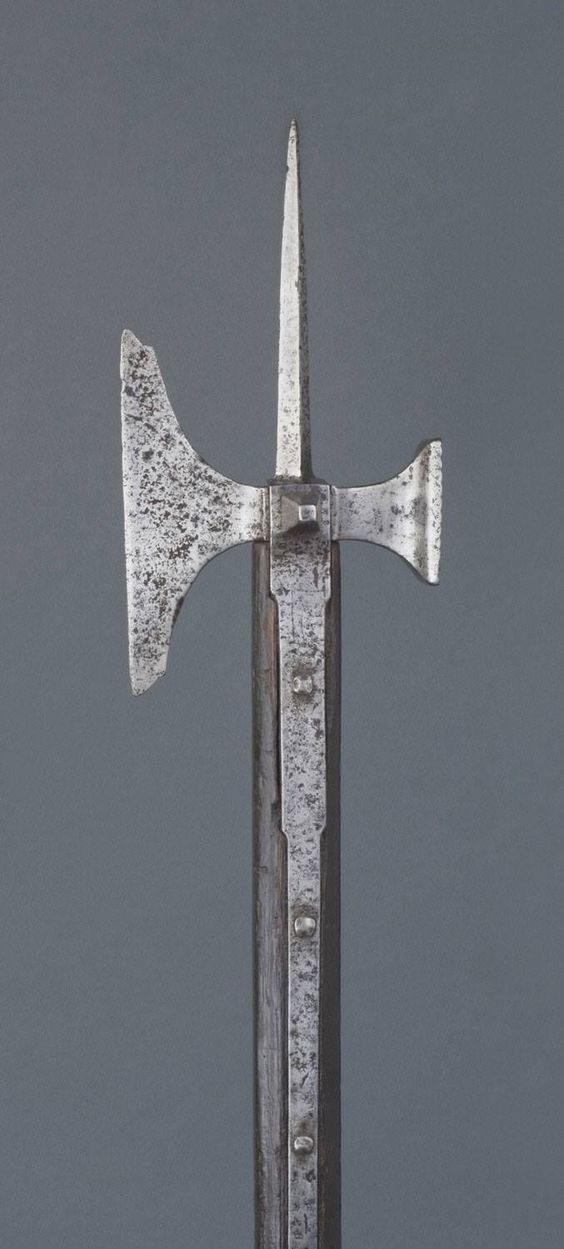
and the lucerne hammer.
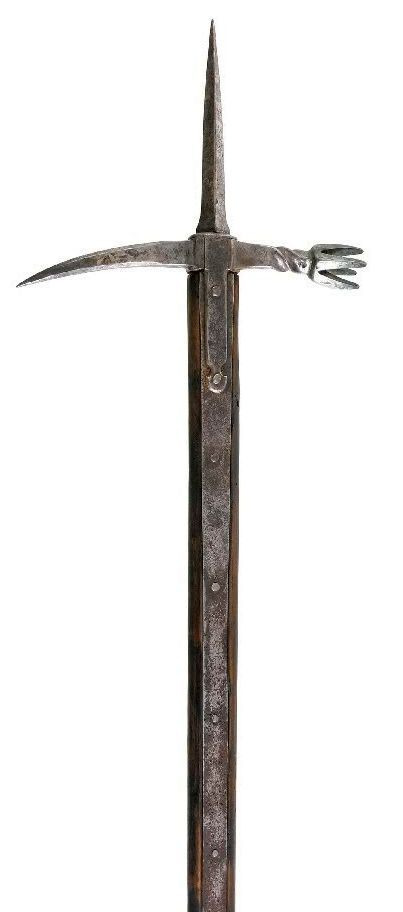
Both of these weapons are typically rather short, and both have a variety of options available to strike with. Both have a spike that can be used for thrusting, if need be, and with the option of cutting, bludgeoning, or spiking, you really can’t go wrong.
Of course, every weapon we’ve discussed so far shares the problem of bulk. In a survival situation, travelling light and keeping your hands free are things to be prioritised. As such, one handed weapons, while not having the advantage of reach that polearms have, are significantly easier to wear and transport.
Swords in particular have historically been carried as side arms and weapons of self defense due to their convenience and ease of wear. This puts them in a superior position over blunt one handed weapons such as the mace
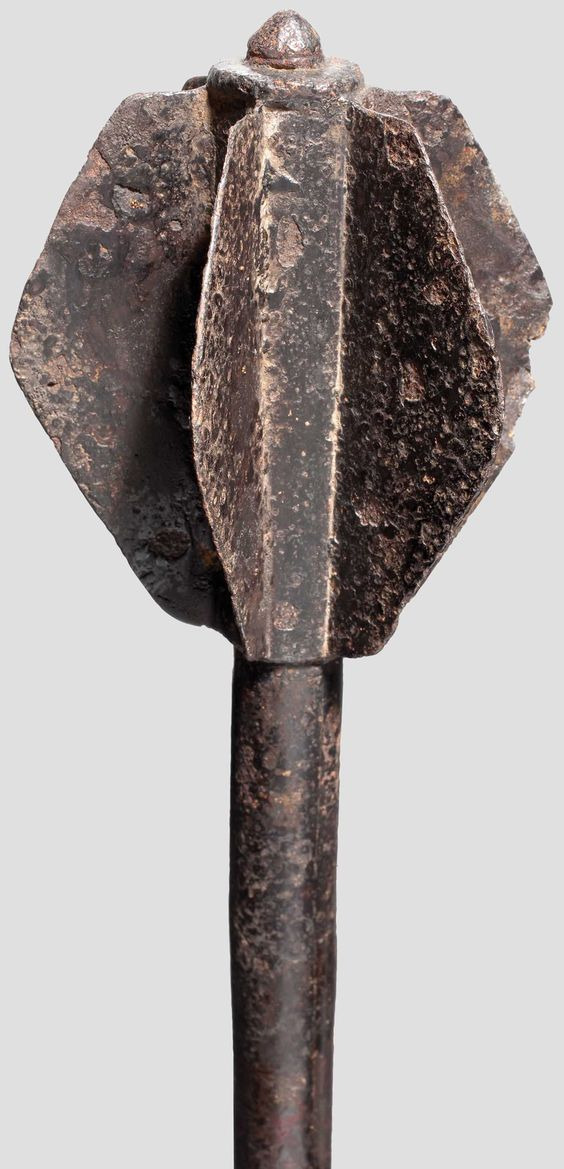
and warhammer,
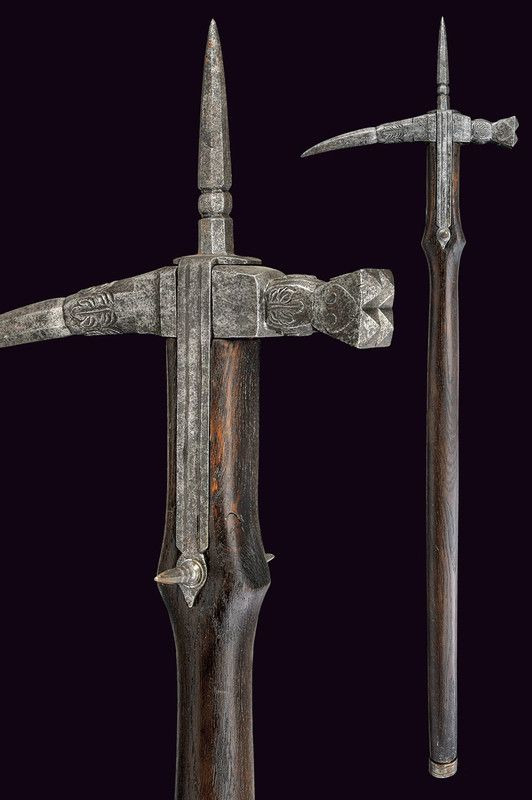
which, while undoubtedly effective, are more cumbersome and difficult to wear.
This of course brings us to the question of what kinds of sword would be most useful. As established earlier, cut centric weapons are more useful against these monsters, which eliminates a large number of more thrust centric swords right off the bat. Another option is available when it comes to swords that isn’t available on other weapons, and this is hand protection. If you are going to be presenting your hands forward to defend yourself against oncoming zombies, a cage of metal around your hand to defend against potential bites is invaluable.
As such, weapons like the longsword,
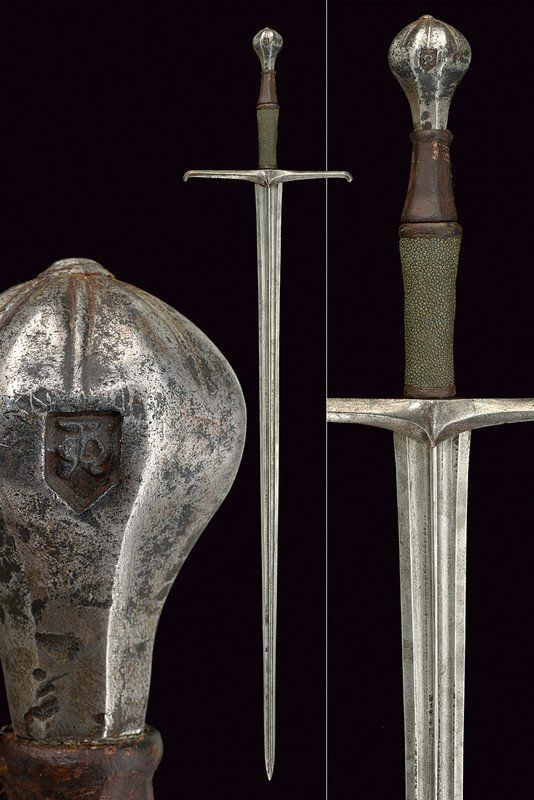
while an effective cutter, puts the hands at risk. This causes me to lean toward a very rare kind of sword known as the Swiss sabre.
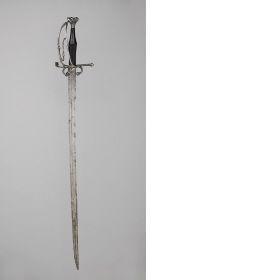
As you can see, the Swiss sabre is a large, two handed curved sword, making it one of the most effective cutting swords available. Equally, it possesses a measure of hand protection, so it would seem to be the perfect weapon. There is however, a snag, and it has been a recurring problem. Even in a scabbard at your hip, these weapons are long, and can be difficult to deal with. This lead us to look at single handed words, and while they aren’t capable of generating the same kind of power, they are still more than capable of removing limbs.
Given our requirements for a cut centric blade with advanced hand protection, we arrive at swords typical of the european renaissance. Broadswords,
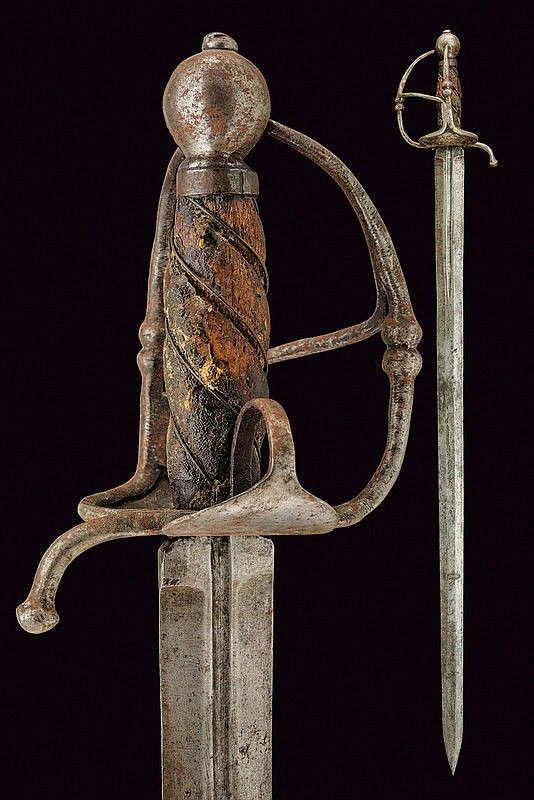
backswords,
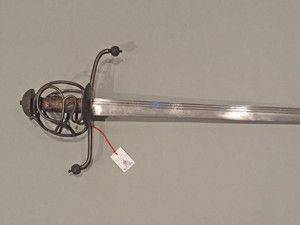
and sinclair hilt sabres/dussacks
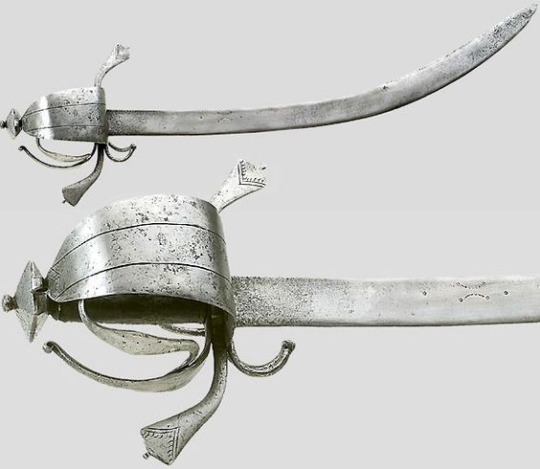
are all good candidates, along with the schiavona,
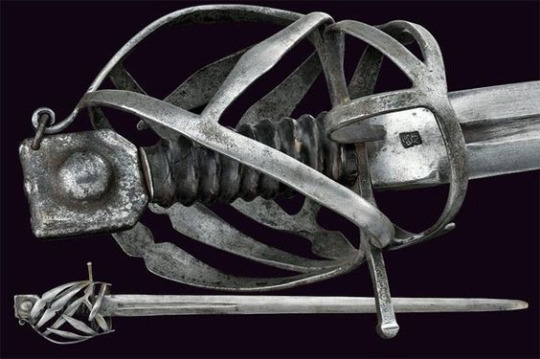
so long as it has a broader, more cut centric blade. All of these are excellent candidates given our stipulations, particularly the dussack. Its curve gives a larger surface area while completing a cut, normally making thrusting more difficult, however this isn’t an issue when facing the undead.
There is one final weapon that hasn’t been discussed that seems suited for the task. This weapon lacks the hand protection that we have established as useful, however this can be made up for by wearing separate hand protection, such as a gauntlet or heavy gloves. Equally, the lack of cage-like hand protection makes the weapon slimmer, increasing the ease of wear even further. This weapon is the falchion.

The profile of the falchion shows clearly the weapon’s purpose. It is weighted heavily forward, with almost all of the blade mass at the very end. This increases the weapon’s cutting capacity immensely. Equally, the falchion tends to have a very thin blade, which reduces resistance as it passes through a target, but makes it almost useless against armor. However, since zombies don’t tend to wear armor, and this weapon is the perfect flesh slicing tool, it is the perfect weapon, so far as the lack of protection can be made up for in other ways.
So, here you stand in the armory, your decision to be made. As far as melee weapons go, this is my suggestion: If you can find a pair of thick leather gloves, or a gauntlet, grab the falchion. It is one of the best cutting swords ever created, and will serve you well. If hand protection isn’t available, take one of the other one handed swords, such as the dussack or the schiavona. It will serve its purpose just as well, and will protect you to boot.
If you eventually band together with others, this is where other options can be explored. As a small roving band, the suggestion is still the same, however if you settle down and create a homestead, attracting more people, this is where the polearms and two handed swords can be of use.
If you have enough people to divide labor, such as giving certain people guard duty, the guards can be given polearms and bows and crossbows, because they don’t require that same ability to move about. If you have small groups going out a short distance to gather supplies before returning, I would suggest sending some people as guards, armed with ranged weapons and polearms, while others go simply armed with one handed sword, allowing them a measure of self defense while also keeping their hands free to do whatever work needs to be done. When the world decays, and society falls into disrepair, heed these words. They may be the only edge you have to survive.
Apologies for yet another absurdly long post, but here it is. Cheers!
812 notes
·
View notes
Photo
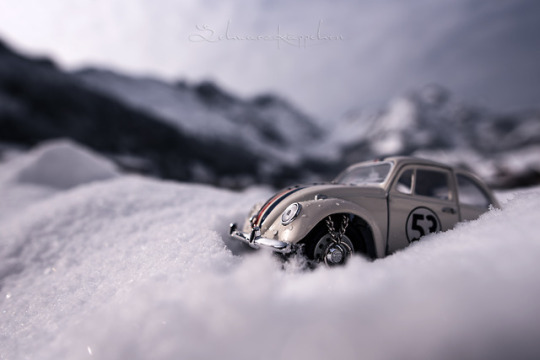
Herbie around the world…
It was quite a long journey for the love bug. After he visited @snowghoul in Greece, Herbie arrived in Lucerne (Switzerland) safely. I decided to be a good tourist guide and show him one of the highlights of our country: The Alps! Engelberg. That’s not far away from home.
But before we were able to leave Lucerne, I had to make sure that he would be prepared for the rough weather conditions in the mountains. Both of us never used snow chains before, so we spent one full night in my garage first. It was worth it though! He was ready for the snow and he really seemed to enjoy his time there.
You will find more pictures of our adventure on my side-blog: und-der-boese-wolf
Please, if you received Herbie, post a photo and tag the photo #Herbie and then mention, who sent Herbie to you and where you took the photo (and if you want to, please also mention @tvoom so that he can see Herbie’s path around the world).
#photographers on tumblr#original photographers#herbie#vw käfer#love bug#toy#car#project#tvoom#herbiearoundtheworld#snow#winter#mountains#alps#engelberg#switzerland
114 notes
·
View notes
Video
youtube
Hal’qarim breaks from the party as they continue onward to Lucerne. They must decide what they are willing to do, and how far they may go, on the path they’ve chosen, and while they may be able to find allies in their endeavor, they also find that there are those who will do anything to prevent peace.
-
Sound may need to be turned up for some of this one, and there’s a bit of background noise due to a different recording computer/location. I made the mistake of turning everybody else’s discord volume way down because it was blasting through my headphones otherwise, but the recording’s volume isn’t nearly so intense for some reason. The different computer I used was a bit…weird, I suppose, with all the audio bugs that have turned up on review. At least it handled the recording without straining and/or bluescreening the way my laptop does.
I’m still hoping to get a better, more permanent solution someday. There’s just been some delays in that plan.
3 notes
·
View notes
Text
What lies beneath: Exploring Lake Lucerne by submarine
What lies beneath: Exploring Lake Lucerne by submarine
“Now it’s going to get dark. Very fast.” The words echoed around the bug-eyed, Sputnik-like capsule as we descended into an afterworld of silence. The sensation – of snowy mountains fading away and sunlight draining from the scene, turning it into a grainy lithograph – set my pulse racing and soon our tiny craft was floating in slow motion in an out-of-focus softness, at minus-70m, near the…
View On WordPress
0 notes
Note
I’d LOVEEEE to hear about Dodger and Alex’s line! I’m super interested in the contributions of captive “ex ferals” in a companion/therapy program
This ask vanished earlier, but now it's back!
Thanks, Tumblr...
Anyway!

Alex

and Dodger
came from Macon Ga, where they were rescued from a billboard by one of the workers hired to break it down.
Who found them jarred from destroyed nests after it came down.
They were nearly weaned, but not able to fly just yet, and ended up severely traumatized by their rescue.

Dodger, the hen, was actually the oldest.

Alex was younger by about a week, which was how I worked out that they aren't nest mates.
Their first two clutches were infertile and rotten, respectively. First egg infertile, second egg fertile, but failed to develop past the first few days.
They were flighty birds, easily startled off nest.

Dio was the first successful baby they had.
Very bright, excessively sweet tempered velcro bird that could have been mistaken for an imprint.
Because she was so clingy, she was adopted out instead of remaining in the program, tempted though I was.

Reo was very slow to develop.
He was one of the peeps I mentioned in a previous post who was too immunocompromised for vaccinations.
I waited until he was nine weeks old to administer them, and that was not long enough.

Murine was practically the perfect bird.
Because he was raised in a safe environment where he had plenty to eat and drink and never had to fear any kind of predator, all the intelligence that Ferals usually have to put towards learning what to watch out for and how to evade efficiently got put towards learning what my behaviors and communication went and how to interact with me.
He was very fast, but instead of being flighty, he was energetic and playful; curious and clever and interested in everything I was doing.
And instead of imprinting on me, he was interested in the hens and social structure for the flock like a healthy, mentally stable pigeon naturally would be.
He paired up with

Ibis: Lucerne x American Show Racer, bred by Mellifex Loft.
Who was every bit as sweet as that face suggests!
A completely shameless cuddle bug.
She was such a strong contender for house bird before we decided to bring Bird-Bird in that she almost didn't join the program at all.
She remained her wonderfully sweet tempered self regardless of where she was or what was going on.
They threw me

Sikku, who ended up being very nervous by nature.

And my big, beautiful boy Ninka, who I kept because his was the mellower temperament of the two.
Sikku and Ninka were some of the last babies to be hatched before we closed, in the worst year the loft has ever had.
This family line has been an object lesson in nature vs. nurture.
Murine hatched in probably the best year we ever had.
He was out of feral parents who were both just unspeakably skittish, so he absolutely had the genetics and upbringing to be wildly flighty and terrified of everything.
But because there were about the number of birds the loft could comfortably house, with babies going home pretty much as soon as they hit nine weeks, and I was in good enough health to easily keep up with tending them, none of the flock had to worry about scarcity or social pressures and he never developed any of the skittishness to which ferals, performers, and field birds are prone.
The keen intelligence and inquisitiveness that keeps ferals alive really got to shine through this one, unimprinted individual, unhindered by the genetics he received to be flighty and skittish.
The mate he took could not possibly have been more ideal for passing on the genes conducive to an even sweeter temperament.
But because those babies hatched when the loft was overcrowded and I was really starting to physically and mentally struggle, the temperament they developed being only about half as skittish as their feral grand parents straight off the street is a real testament to Ibis' genetic contribution.
19 notes
·
View notes
Text
I Have a 2006 Buick Lucerne, While Driving with AC on, a Message Come Out That Says Turn AC Off, Car Is Overhe?
If the overheating problem is being caused by the AC then change your thermostat as that is the most likely problem. Note: This is assuming that you have appropriate level of coolant and its not leaking, proper working fans that spin fast enough and spin when they are suppose to, no blown head gasket, no clogged radiator and a good radiator cover that holds the pressure required. ⢠Other Questions Is radiator cleaner safe to use?
deposits of crud or corrosion could be sealing a potential leak. You run the risk of having a leak develop. A regularly maintained car had nothing in the cooling system that needs any cleaner.
Now if you have a nasty cooling system that hasn't been maintained then cleaning out any corrosion or build up will very likely cause a leak so I wouldn't put any cleaner in it. ------ 1997 grand am question, about removing the frame on top of the radiator? The Grand AM does not have a radiator cap, it has a pressurized resivor.
This means that the resivor is a full part of the cooling system, and not just a place for overflow. The cap on the resivor is threaded onto the resovor and is sealed just like a standard radiator cap, this is where all the filling/top offs are done, there is no radiator cap, but there is a resivor cap. Many vehicles are like this.
------ I can't get heat in my 92 GMC Sonoma, what should I do? Ive had a lot of problems with after market thermostats, even though it new dosent mesn its good, i reccomend going and buying a dealer (chevy) theromstat and then try it again, also your radiator could be stopped up and not cirulating properly, dont use the dexicool antifreeze long term i know it to stop up radiators i went through the dsame probs you are, try having the radiator recored or replace it, i bet it will work ------ wat would happen if i cover my front grille of my car will this do any harm to it? Depending on the vehicle it can absolutely do harm.
Some diesel vehicles in the winter will cover their grills with a finer mesh to limit the cold air going through, but most gasoline vehicles require the airflow. When the car is stopped, if the coolant heats up too much the radiator fans will kick on and pull the air through forcefully. If air cannot get in, the engine will overheat ------ should i buy this used car?
What year is it? If it's a '94-04 S-10, I'm not surprised that it needed a transmission seal or a valve cover gasket. Especially if it's a V6 with the automatic.
If it's an older S-10 then there will be less to go wrong, but if you do buy it make sure the seller throws in a free water pump. If the radiator needed re-coring, chances are the water pump is the next to go. ------ What is the best cleaner to clean bugs off a radiator?
I've never known anything that was considering good in removing bugs from a radiator. I drive a semi and I assure you that my truck is covered in bugs. I simply wait for them to literally dry out and then you can brush them off.
There are screens that you can get that are easy to remove and clean instead of letting them get into the vanes of the radiator. Give that a try ------ What happens when bike engine is covered with a water which is covered by a box? That would be called a 'water cooled engine' .
they usually have a radiator to exchange the heat from the water surrounding the combustion chamber and a mechanical water pump to transfer the waste heat into cooler air passing threw that radiator allowing accurate temperature control under sustained continuous use under varying load conditions . Unless you have any thing other than a new 2014 Harley Davidson.the idea has been around in commercial use far longer than a century now!
------ Can I put a couch next to a radiator? its summer time now,,right? so not to worry.
anyway a radiator will never get hot enough to start any fire. But in the winter when you need the heat you have to keep the couch about a foot away so the heat can radiate about the room. Also keep the winter drapes short so's it wont divert the heat up the wall.
Hope this helps answer your question. ------ How to replace Valve Cover Ground Cable on 2000 Honda Civic Si? Anyplace on the engine block will do it - I always thought the valve cover was an odd place for it anyway.
An alternative is to get a battery negative cable that has an extra lead to screw down to a chassis ground near the battery. That wire (in either location) provides the engine ground. If it is not making contact all sorts of weird electrical things happen ------ Recently installed 12v Bosch horns on my Accord.
I don't think that there would be any problem at all since horns found on civics (atleast those sold here in the Philippines) are installed in the same general area behind the grill and just infront of the radiator and airconditioning unit. Actually, I was thinking of replacing my stock bosch horns with FIAMM horns. They're longer and would probably be installed in the same place as my stock ones.
Peace. ------ How do I fix a radiator leak I know is in my engine? This is known problem with those engines.
I would check the timing cover on the inside. When the timing chain guides break, the chain rubs the inside of the timing cover and rubs a hole into the water jacket. Most people think that its a blown head gasket.
Aftermarket water pumps also may wear a hole in the timing cover from the impellers rubbing through. I recommend factory timing components and water pump ------ My 2006 Chevy Malibu isn't heating up right.Any suggestions?
first id check to see if thermostat is opening and closing and if its really cold put a box flap infront of radiator just dont cover the whole thing just a small part like the flap of a box works great to close off some air should help it heat up back east or up north but most likey its thermo stuck open if it doesnt get hot or it takes a long time its open and stuck ------ Anyone have any information from start to finish about a 93 Ford Tauru? The fan relay tends to go bad and is located on top of the radiator under the plastic cover. Remove the plastic top cover located around the top of the radiator.
If your going to keep the car, you might as well just buy a new fan relay and replace it. If it doesn't fix the problem, you'll have a spare if needed in the future ------ Engine overheated & will not start plus spark plugs are covered in oil. Sorry to hear, but it sounds like a blown head gasket.
Check for water or a white film on the plugs also, and if and when it does start again, look for steam coming out of the exhaust, lots of it, it may just be something simple due to it overheating. But I would be real careful, and try a junk yard for a used part like the hose. No duct tape.
. that's a shame. ------ Hi name is Jay I have a 98 Oldsmobile intrigue and I do a little work on my own.
Sounds to me Jay like your converter is plugged up. How's the acceleration? Sluggish.
Try a night drive and when it acts up, wear some old clothes and check out for an orange glow in front of the converter. Careful you don't get burnt. If it isn't that, you have a cracked head or bad head gasket and it isn't showing up yet, so watch for white smoke.
good luck. ------ Cannot find radiator bleed valve? Can anyone help?
Pictures included!? Higher pressure in boiler could be sign of many factors including air bubbles in the system.
Air comes in from where water is leaking out. So find that location. Radiators or pipes leading to radiators must have air vents to let air out.
Boilers have valves for fill or drain. If none of the above helps, the only way would be to loosen (not open) the union next to the radiator valve to let water to leak out. ------ What Does the BMW Maintenance Program Cover?
The initial 4yrs/50K miles warranty and maintenance would certainly cover those leaks. Other than that they also cover brake pads and rotors, oil change, drive belt, brake liquid, and more. For more information see: http://www.
bmwusa.com/standard/content/owner/bmwultimateservice/default.aspx The extended CPO warranty (6 yrs/100K miles) doesn't cover maintenance costs beyond the initial 4 yrs/50K miles and has some limitation on warranty compared to the initial period as well.
------ what is the plastic thing holding up my lower radiator hose? my cars a 1995 3.4 camaro?
Take a picture, and take it to any Auto parts dealer, show them the picture and explain it what it is. They can usually pull up pictures (maybe). I did this before because there was a missing cover piece at the bottom of my transaxle, they identified it for me and it was called an inspection plate.
Your piece that snapped must be called "radiator hose support" (just a random guess) ------ i need help changing my radiator on my 2000 volvo v70se? Drain rad. plug on bottom of radiator,remove fan and shroud,unplug wires, usually two screws.
may have to disconnect top hose first. remove top and bottom hoses on rad. disconnect trans.
line on side of rad. if auto trans. May have to remove plastic cover over rad.
Should be a bracket at top each end remove, then lift out. Reinstall reverse order make sure tangs on sides go into slots in frame ------ 95 12v cummins oil leak location? start fresh, pressure wash the engine.
It will not affect the engine like it would a gas engine, i do it everyday. Pressure wash every thing, the radiator, engine, the under carriage, oil pan, transmission, the works. Make sure fliuds are ful land drive it.
Possible casues: powersteering mounting gasket, front crankseal, blowby/roaddraft tube, oil pan gasket. if youneed anything , email me [email protected].
happy turkey day. alan ------ Anyone else have steam radiators throughout their house and a baby? This might sound bad, but most kids will burn their hand(s) at least once when they are little.
So sometimes it might take your kid that one time to put his hands on it and know that some things do burn. Not unless you are watching your kid 24/7 it will most likely happen. I would suggest not using them and getting the space heaters instead.
They are inexpensive and don't cost much to run them ------ How much should it cost to change radiator in 2001 chevy impala? There is a price estimate book we use in my dealership I will quote you the cost.To replace the radiator in a 2001 impala that also covers coolant,clamps,and a new radiator cap parts and labor a dealers cost is $737 plus tax.
Independent shop price for the same repair is $531 plus tax. These prices will not be off by more than 10%.Best of luck with your impala ------ is hitting a deer covered under "basic" insurance?
.or do I need collision/comp? If you have only liability or "basic" coverage, it pays nothing for damages to your own vehicle, under any circumstances.
Liability covers damages and injuries caused to others by your insured vehicle. Submitting a claim soon after changing your coverage would set off all kinds of red flags at the insurance company. You could be investigated and prosecuted for fraud.
Are you sure you want to do that? ------ Does spray painted Styrofoam help heat a house? Well, most spray paints will melt styrofoam so there's that problem.
It would be better to cover the styrofoam with foil, and quite frankly, as the radiator shouldn't be getting hot enough to affect the wall behind it you could just put the foil on the wall. I suspect the result would be negligible as most of the heat is already just going up, not so much out. ------ Reasonable radio antennas range from1 centimeter to5 meters in diameter.
What frequency range does this cover? 1cm is communications and radar. 5 meters is communications.
1 cm is about 18 GHz. 5 meters is about 56 MHz. These are estimates, so give or take a few MHz.
We use 3 cm radar on ships (9GHz) and 10 m in ham radio, which is about 28 MHz. And it isn't diameter that is important, although at high frequencies that isn't true, but the length of the antenna is important for good transmission. ------ Does using a piece of cardboard in front of you radiator really allow your car to heat up faster on cold days?
You are correct. Your thermostat will remain closed until your engine reaches the right operating tempature. Your cooling fan only comes on when your engine reaches a specific tempature, and this is well after it warms up.
The cardboard will only help if your thermostat is stuck open all the time. At that point just spend the 5 bucks and replace the thermostat instead of messing with a big peice of cardboard
0 notes
Text
Do You Dare Enter Any of These 10 Abandoned Homes for Sale?
realtor.com
For those committed to the spooky spirit of Halloween, we’ve managed to scare up 10 abandoned homes currently for sale. We’re well aware that none of these homes are what most would call “beautiful”—in fact, many of us would only walk inside on a double-dog dare.
However, this is the time of year to embrace those goosebumps and little hairs raised on the back of your neck. Many of these forlorn homes are actually too dangerous even to enter, but the pictures alone will give even the toughest haunted house veteran a case of the willies.
It’s the little things left behind that make these places truly haunting. Baby stuff, old furniture, even the trash, hint at a time when these places were vibrant, bustling homes—until something went awry.
The upside to these eerie vibes? Many of these properties are bargain priced, and you can use all your powers to bring them back from the half-dead.
So break out the fun-sized candy, press play on your Halloween Spotify mix, and tour these abandoned residences for a monster good time.
33 Parker Rd, Sanford, NY
Price: $69,000 Remodel, interrupted: Built in 1970, this three-bedroom ranch home was well on its way to being turned into something special, when the owners abruptly changed their minds and split. Now overgrown weeds greet anyone brave enough to set foot on the property. But once you step inside, you’ll find a kitchen that’s nearly finished and hardwood floors in most rooms. A full bath has already been stripped down to the studs and is ready for an upgrade. The acre-plus lot sits at the base of mountains, making this a special little retreat with nearly limitless potential.
Stanford, NY
realtor.com
———
4820 Indian Head Hwy, Indian Head, MD
Price: $105,100 Enter at your own risk: Built in 1942, this abandoned home overtaken by Mother Nature isn’t safe to enter. It sits on a half-acre lot, and another adjacent full acre is available for $60,000. The grassy lot is a lovely backdrop to the home, which has been ravaged by weather and the elements. The listing suggests that potential buyers consult an expert about the possibility of salvaging the home.
Indian Head, MD
realtor.com
———
1393 Halo Dr, River Falls, WI
Price: $165,000 Tear-down farm: This abandoned over 23-acre farm has several buildings, all of which are in various states of disrepair. There’s even a car stuck in the midst of an overgrown field to add to the creepy frozen-in-time vibe.
River Falls, WI
realtor.com
———
5755 Roy Cooper Ln, Cedar Grove, NC
Price: $89,900 Termites, spiders, and trash—oh my!: What was once a family compound is now a home for all sorts of bugs and wildlife. The over 2-acre lot includes a block home, which the listing says is “loaded with termites, spiders, rotted out floors, trash, and debris,” and a double-wide trailer. Fix it up, scrap it all, or maybe just burn lots of sage—the choice is up to you.
Cedar Grove, NC
realtor.com
———
731 E F St, Newton, NC
Price: $10,000 Creep-tastic cottage: This two-bedroom bungalow was built in 1900, but is no longer safe to survey because of its collapsed floors and falling roof. There’s also a “walk-in partial crawl space” that’s probably not much safer. There are also piles of trash, including furniture, baby equipment, and old mattresses wrapped in overgrown vines, giving the whole property a decidedly haunted vibe.
Newton, NC
realtor.com
———
1 Dido Ave, Lucerne Valley, CA
Price: $24,950 Abandoned cabin: This 400-square-foot abandoned cabin sits on 5 windswept desert acres. The current owner is willing to carry with only $10,000 down and negotiable terms, making it a bargain for anyone who doesn’t get a little freaked out by being stuck out in the middle of nowhere in an abandoned cabin.
Lucerne Valley, CA
realtor.com
———
8260 Fairplay Rd, Somerset, CA
Price: $749,000 Condition unknown: This gorgeous 60-acre parcel sits in the Fair Play American Viticultural Area and has three ponds, meadows with walnut and oak trees, and views. The home on the property was built in 1888, and has been neglected for years. The listing adds that the current condition of the home is unknown, and that anyone who enters does so at their own risk.
Somerset, CA
realtor.com
———
504/502 Jones St, Sumter, SC
Price: $19,900 Bare bones: Don’t visit in the dark. This brick house with boarded-up windows is a stripped-down two-bedroom, 662-square-foot structure. The price also includes a vacant, unimproved adjacent lot. It’ll take a daring buyer.
Sumter, SC
realtor.com
———
43369 Mountain View Ln, Burns, OR
Price: $179,000 Spooky ranch: This fenced 217-acre parcel has never been occupied by its current owner. To amp up the fright factor, it includes a manufactured home of which the contents are unknown. The land could be used to build a dream home, hobby ranch, or even a haunted house and corn maze.
Burns, OR
realtor.com
———
1361 Mt Vernon Ave, Mays Landing, NJ
Price: $28,500 WARNING, unstable: This bungalow built in 1938 is a complete tear-down project, and buyers are warned in the listing that the home doesn’t have a stable foundation or or ceiling. The real value is in the land, a quarter-acre lot perfumed with clumps of wild lavender.
Mays Landing, NJ
realtor.com
The post Do You Dare Enter Any of These 10 Abandoned Homes for Sale? appeared first on Real Estate News & Insights | realtor.com®.
from https://www.realtor.com/news/trends/do-you-dare-abandoned-homes-for-sale/
0 notes
Photo

@billboard just premiered "Rooftops" – a brand new single from Prawn, which they called "a breezy, whistle-laced four-minute bop."
If you haven't already pre-ordered their upcoming album, Run, head over to our web store.
Upcoming tour dates:
9/15 - Hackensack, NJ @ The Alementary (Run listening party)
9/21 - Paris, France @ Le Gibus ^
9/22 - Diest, Belgium @ JH Tijl ^
9/23 - Amsterdam, Holland @ Sugarfactory ^
9/25 - Hamburg, Germany @ Hafenklang ^
9/25 - Berlin, Germany @ Cassiopeia ^
9/27 - Dresden, Germany @ Scheune ^
9/28 - Hannover, Germany @ Bei Chez Heinz ^
9/29 - Nurnberg, Germany @ Desi ^
9/30 - Prague, Czech Republic @ OO7 ^
10/1 - Vienna, Austria @ Arena ^
10/2 - Budapest, Hungary @ Durer Kert ^
10/4 - Ljubljana, Slovenia @ Gala Hala ^
10/5 - Seregno, Italy @ Honky Tonky ^
10/6 - Lucerne, Switzerland @ Sedel ^
10/8 - Munich, Germany @ Kranhalle ^
10/9 - Stuttgart, Germany @ Keller Klub ^
10/10 - Cologne, Germany @ MTC ^
10/12 - Brighton, England @ The Hope ^ %
10/13 - Southampton, England @ Joiners ^ %
10/14 - Bristol, England @ The Exchange ^ %
10/15 - Manchester, England @ Rebellion ^ %
10/17 - Newcastle, England @ Think Tank ^ %
10/18 - Glasgow, Scotland @ Stereo ^ %
10/19 - Leeds, England @ Brudenell Social Club ^ %
10/20 - Nottingham, England @ Bodega ^ %
10/21 - London, England @ The Dome ^ %
10/22 - Kingston, England @ Fighting Cocks ^ %
TSR Tour w/ Slingshot Dakota & People Like You –
12/9 - Washington, DC @ Song Byrd *
12/10 - Richmond, VA @ Strange Matter *
12/11 - Chapel Hill, NC @ Local 506 *
12/12 - Atlanta, GA @ The Masquerade *
12/13 - Newport, KY @ Southgate House *
12/14 - Chicago, IL @ Beat Kitchen *
12/16 - Lansing, MI @ Mac's Bar *
12/17 - Cleveland, OH @ Mahalls Downstairs *
12/19 - Pittsburgh, PA @ Funhouse +
12/20 - Rochester, NY @ Bug Jar +
12/21 - Boston, MA @ Middle East Upstairs +
12/22 - NYC, NY @ Baby's Alright +
12/23 - Philadelphia, PA @ Kung Fu Necktie +
^w/ The Flatliners % w/ Shit Present *w/ Us and Us Only + w/ Queen Moo
More info
#prawn#rooftops#single#billboard#premiere#music#topshelf records#european tour#tour#the flatliners#shit present#us and us only#queen moo#slingshot dakota#people like you#tsr tour
5 notes
·
View notes
Note
Hello! I was wondering what sort of requirements pigeons would have and the whole breeds thing. (Sorry long ask) How much room would a pidge need? Like cage size and also, how would one go about excersizing them? Do you reccomend letting them fly free for the day and come back at night? Would they possibly get hurt or catch a disease/parasites out there? Are they expensive to keep? And what breeds are the most friendly/affectionate? Thank you :) 1/2
You know how some dogs have been bred to look nice but have a multitude of health problems (ie pug, chihuahua, great dane ,dachshund ect) does that happen in pigeons too? And if so, how does one know which might be genetically predisposed to getting problems later on or just generally wont have the best quality of life? 2/2
Whuf!
These are really broad questions. I’ll have to break them down and answer ne at a time, so I apologize in advance for the length of time it will take me to get this ask out.
“How much room would a pidge need? Like cage size...”
Pigeon breeds range in size from the tiny Valencian Figurita and Portuguese tumblers (vying constantly to be the worlds smallest breed) to the literally chicken sized Giant Runt.
So the amount of space required depends on the breed’s size and energy level.
Homers are about the average.

Here is an old picture from before the loft’s redesign of two of my breeding pair in their pens.
These are labrador sized dog crates, outfitted with a rabbit’s corner litter pan as a nest box and a garden stake cut to length as a perch.
Pigeons need flat perches because they are cliff nesters. Round ones like branches or dowels hurt their feet.
If yours is going to be a house pet, the cage should be what a crate is for dogs: A safe place to sleep or wait for you to get home until it learns the house rules.
Pigeons are intensely social birds that are happiest with the freedom of motion to come see you when they want, and go occupy themselves when they don’t want company.
The nice thing about pigeons is that they don;t need to be all over you all the time. They are independent enough to go do their own thing, but want to be able to come check on or spend time with you.
Which dovetails nicely into your next question: “how would one go about exercising them?”
A pigeon allowed to free range indoors will exercise themself plenty.
If you cannot let them free range the entire house, letting them out in your bedroom while you are home will be fine for most breeds.
“Do you reccomend letting them fly free for the day and come back at night?”
Absolutely not!
“Would they possibly get hurt or catch a disease/parasites out there?”
That possibly could be turned all the way up to a guarantee.
Performance breeds like racers, rollers, and tumblers are over bred to make up for the losses during training flights from inclement weather getting a bird lost, hawks snatching them out of the air, and diseases picked up from wild birds and brought back.
“Are they expensive to keep?”
After the initial cost for set up and the vet check to make sure they don’t have parasites and aren’t ill, the upkeep for a few is shockingly cheap.
You can get a lab sized kennel for $50-70. If you want an even bigger space, Great Dane kennels are about $80.
You can buy a wooden garden stake from pretty much any hardware store for about $5.
The bunny corner box is not required if you aren’t breeding. Pigeons will just as happily use a dollar store dog bowl to nest in.
My vet bill for a new bird is $70: $35 for the exotics wellness exam, $20 for a throat swab, and $15 for a fecal test.
I expected feral and lost birds to have lice, worms, parasites, and infections, but was floored when every single show bird I ever purchased from breeders did too!
You’re better off in the long run assuming something needs to be healed, cleaned out, or cleared up and just finding out from the vet as soon as they get there what needs treating.
Clear it out then, and an inside bird is pretty well set.
You can buy 50lbs of feed for $20 at Tractor supply.
And 50lbs of calcium supplements for $11.
I have 36 pigeons and 2 ringneck doves right now, so 50lbs lasts me a little over a week.
But a single bird will eat off of that for over half a year.
“And what breeds are the most friendly/affectionate?”
Most of the Exhibition breeds are pretty friendly, but from most to least kennel space, here are the ones I have enjoyed the most hands on:
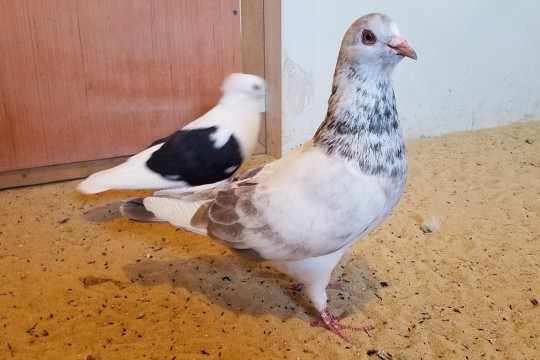
Utility kings
These are the size of chickens and will need a LOT of flight time.
They are a meat breed, so they are genetically predisposed to docility, but also obesity.
They do best free roaming the house full time. It’s really hard to find a cage big enough to comfortably accommodate them.

Giant Homers
Utility kings are a squabbing breed, designed for constant production of big squabs, so they are more bird-shaped than the Giant Homer, which was bred to be eaten as an adult, and then for the aesthetic of a fat round bird.
Like the Utility King, Giant Homers are known for their mellow, gentle temperaments. But after having worked with them for a few years, it seems mostly to be that they are simply too big and heavy to evade effectively, and they know it.
Along with being prone to obesity, their sheer weight puts tremendous pressure on their feet and they can develop huge, painful calluses.
I like my mixes better than their purebred parents, because they inherited the temperament with out the bulk that causes painful or dangerous health issues.
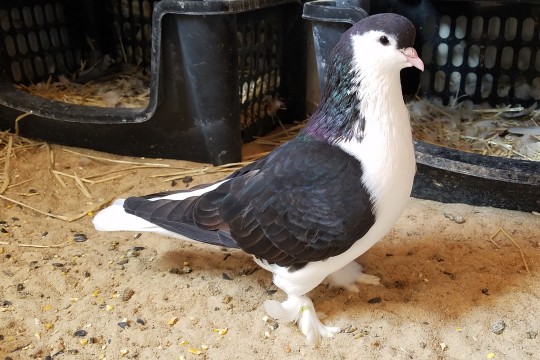
Lahore
Named for the city in Pakistan where they were developed, the Lahore is a huge, gorgeous bird.
Their wing span more then the size of their actual body makes them difficult to cage, so it’s best they have the run of at least a bedroom.
these are laid back and mellow, but not exactly touch me birds. If one gets on your shoulder or in your lap, feel honored.
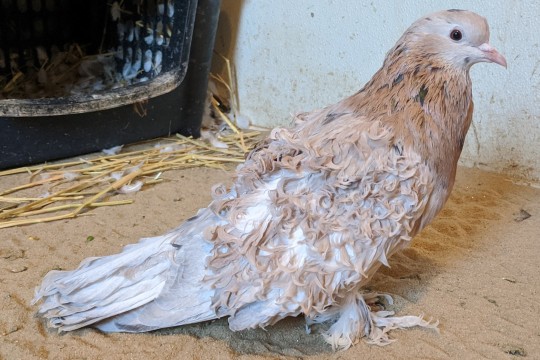
Frillbacks
For the same reason as the Lahore, Frillbacks can be difficult to pen indoors.
An individual can be happy in a Great Dane sized kennel, but frankly won’t fit comfortably into anything smaller.
These are very laid back, not especially flighty, and quite friendly. Young birds are very much cuddle bugs, and the individual pictured still comes up to me to nurse between my fingers.
No known associated health issues, but individuals with especially long muffs can stay especially still because the shaft of the feather under the skin of their feet is bigger around than the bones of their toes, making walking painful.
Show standards require large muffs, so it can be hard to find them with muffs like Bean’s here.
There is one breeder that raises hers with short muffs and entirely clean legged. I’ll be happy to link you.

Voorburg Shield Cropper
These leggy, slender birds are a pain to house because of their height, but the only breed I know of with points taken off in the show standard if they are not friendly enough to try to court the judges.
This sweet flamboyant temperament makes them an absolute delight to work with!
These are the first on the list with no known health issues associated with the breed.
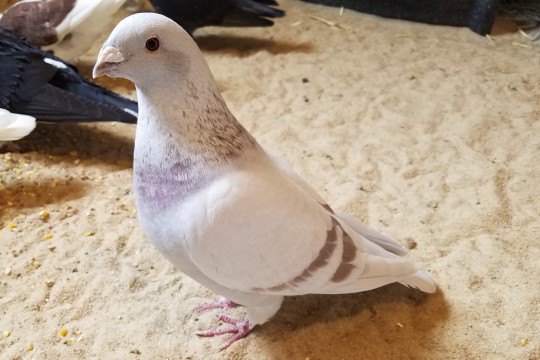
Show Type Racing homer
This is an elegant exhibition breed, easy to house in the example set up we discussed at the beginning of the ask.
They are bulkier than racing homers or flying type show homers, VERY tightly feathered.
This is a wonderfully sweet tempered breed that tends not to be especially flighty.
Some of that is due to the sheer bulk of its musculature, but most of it does genuinely seem to be temperament.

Old Dutch Capuchine
These have a reputation for being docile, but I have found them to be quite flighty.
Mixes incorporating this breed, though, tend to be quite bold and out going.
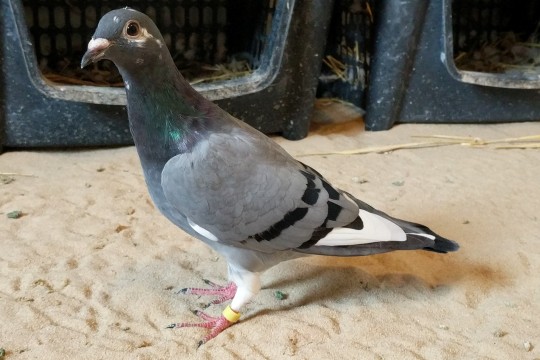
Racing Homer
This is the most commonly available pigeon breed.
Bred for endurance racing, this is a very high energy bird that needs a LOT of time out of the pen to fly.
They have the strongest immune system and highest intelligence of any of the pure breeds.
though some individuals can be hair-trigger flighty, this breed is keenly intelligent and highly curious, and those individuals can learn to overcome their flightiness if their handler can learn to be aware enough of their comfort levels not to startle them with too-quick motion.

Lucerne Peak Crest
Named, like the Lahore, after the city in Switzerland where the breed was developed.
The Lucerne is an extremely temperature hardy breed.
It’s among what are called the Owl Breeds; small, compact breeds with short to mid length beaks, round faces, and large, round eyes.
Most of the owl breeds are mellow and sweet tempered, boldly curious, and not generally prone to be flighty.
Their beaks being a little short makes their nasal slit narrow and the opening to their sinuses wide, so small seeds like Millet can get stuck in the nasal cavity of some individuals.
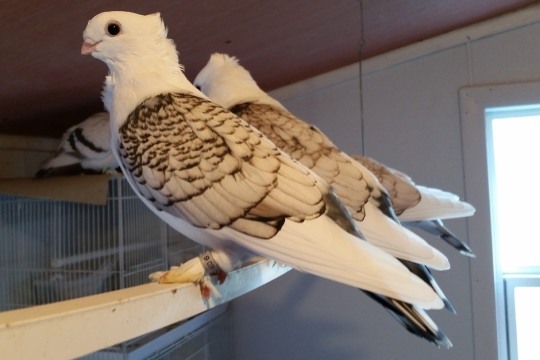
Classic Old Frill
Oh, this is my favorite purebred.
The total pidge package: Small, friendly, shockingly beautiful, devoted parents.

There is absolutely everything to love about this wonderful cuddle bug breed.
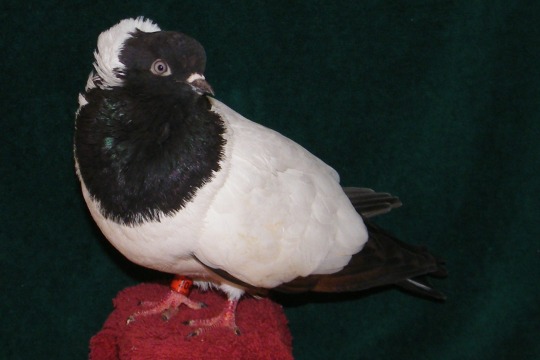
Nun
These are a gorgeous breed, often described as being friendly because they are not smart enough to be wary.
They are unspeakably awful parents, prone to literally treating their eggs like an especially large, uncomfortable poop.
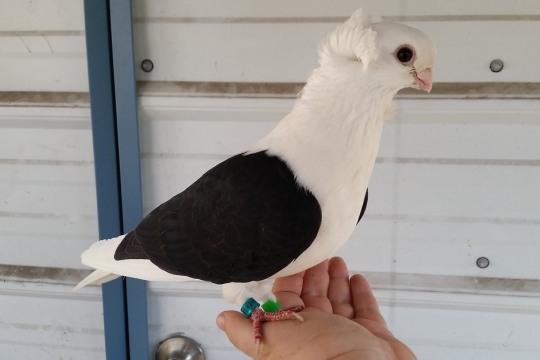
Old German Owl
Another absolute delight of a charming little Owl breed.
These are as stubborn as they are sweet tempered, which can make them a really fun challenge to train.
These are cuddle bugs, for the most part.

Chinese Owl
These are tiny little clouds that range from intensely curious and strongly treat motivated to absolute refusal to have anything to do with anything even remotely human shaped with very little in between.
Small and easy to house.

Portuguese Tumbler
This is a tiny bird, not much taller than a conure.
They are bred purely for aerial performance, so this is a SUPER high energy breed that, like the racing homer, needs a LOT of out time.
They are very bold in their friendliness, eager to check up on you and steal a cheek-smooch before zooming off to resume doing their own thing.
Unfortunately, their breed standard requires their back toe not to touch the ground. They go on tippy toes when they are happy, excited, or relaxed, which makes something like a human hand or shoulder physically difficult to balance on, and there for uncomfortable to stand on.
So trying to pet one throws their balance and stresses them severely.
Mixes with stronger feet are thrilled to have the affectionate attention of human flock mates.

Valencian Figurita
The tiniest owl breed, currently just barely winning out over the Portuguese tumbler.
It’s known for its trapezoidal head shape and upright stance.
This is a bold, plucky little bird that in my experience loves shoulders. ^v^
They are bred a little too small, though, tending to only lay one egg to a clutch, with many dying in the shell with out space for the peep to develop.
Their hatchlings are often given to ringneck doves to foster.
“You know how some dogs have been bred to look nice but have a multitude of health problems (ie pug, chihuahua, great dane ,dachshund ect) does that happen in pigeons too?”
Oh, god, you would not believe the number of pigeon breeds that aren’t even bird shaped!
There are nearly twice as many severely distorted breeds as fit, bird shaped ones.
Check the Modern art Pigeons tag.
“And if so, how does one know which might be genetically predisposed to getting problems later on or just generally wont have the best quality of life?”
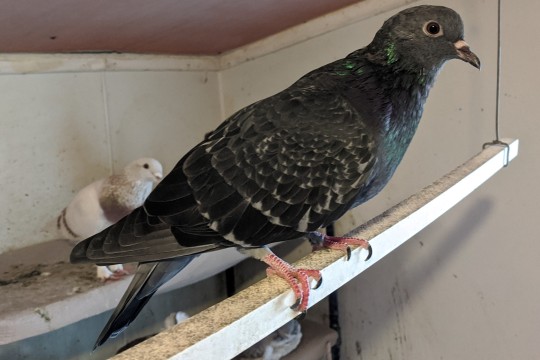
Pippin is a feral pigeon.
This is about the closest you can get to the base line natural shape of the species Columba livia.
The more pigeon-shaped the breed, the better.
Ferals are, genetically, a blend of the homers, rollers, and tumblers that survived getting lost on training tosses or during performances.
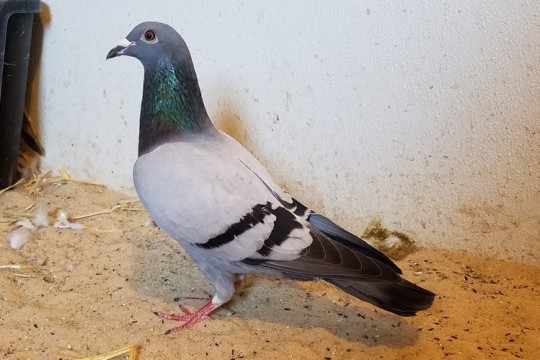
Here is Wilson, another purebred Racing homer.
Because this breed is designed to fly marathons literally hundreds of miles, it’s a lot more compact and muscular than Ferals and genuinely wild Rock Doves, who only need to fly as far as it takes to find enough to eat in a day.
The farther off this base line you go, the less physically fit the breed.

The American Fantail is an especially heinous train wreck.
Its chest is out thrust over its head, its neck curves parallel to its spine, and its head is propped up by its own tail feathers.
youtube
This pitiful creature is not just displaying.
youtube
Their skeleton is permanently stuck in that shape.
Parlor rollers are bred with a combination of neuromuscular defects that throw their balance when ever they flap their wings, sending them into a panic as they flail to right themselves.
youtube
Parlor Tumblers have a less severe version of the same group of deformities:
youtube
We talked about the Old dutch Capuchine above.
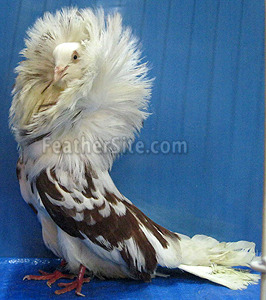
Jacobins are the extreme “modern” version of the ODC.
You could trim their feathers to clear their field of vision
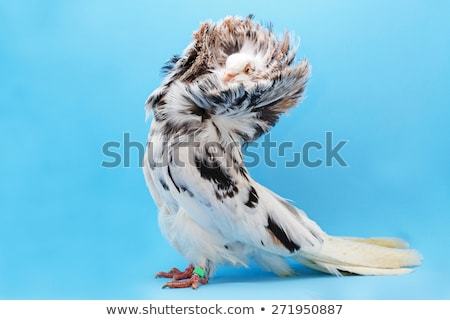
But their very long necks tend to collapse into their shoulders with age.
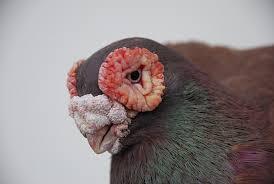
The male Barb’s huge, wrinkled wattle and ceres block off their nasal passages and deform the eyelids so that they may not be able to fully close.
Cocks usually go blind with in three years, but that doesn’t matter to their breeders because their peak show and reproductive performance is between their first and second year of age.
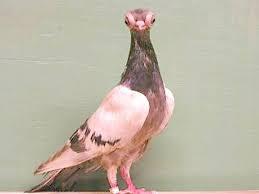
The Short Faced Budapest’s show standard requires its eyes to telescope as much as possible.
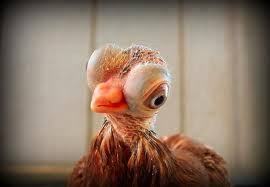
Its eyes are literally bigger than its skull, and don;t fit in their sockets.

The eye lid is all that holds them in.
And some can’t fully close their eyes.

This is the Oriental Frill, also called the Modern Frill.
they have literally no beak.
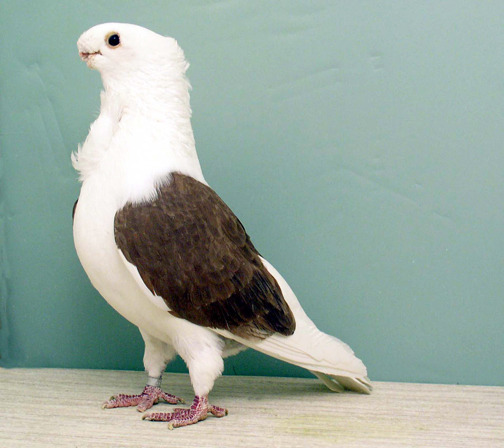
Turbits have a longer head, but a nearly inverted beak.
These birds can;t feed their own young, and struggle to preen themselves.
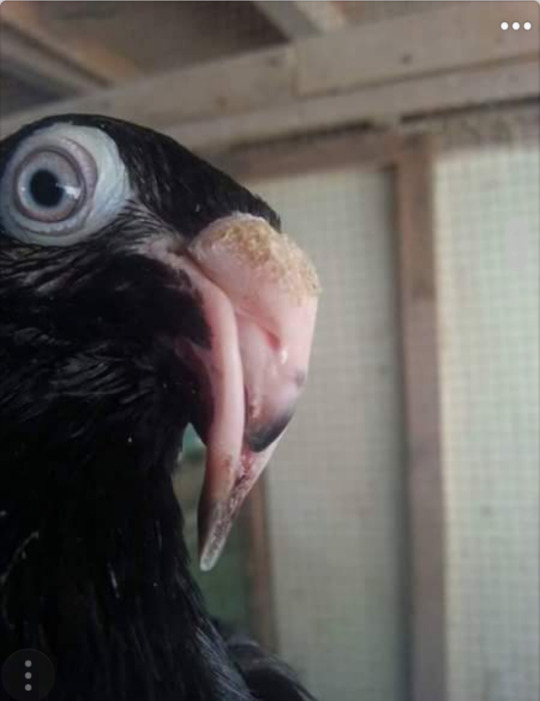
Aaaand here is the Egyptian Moraslat
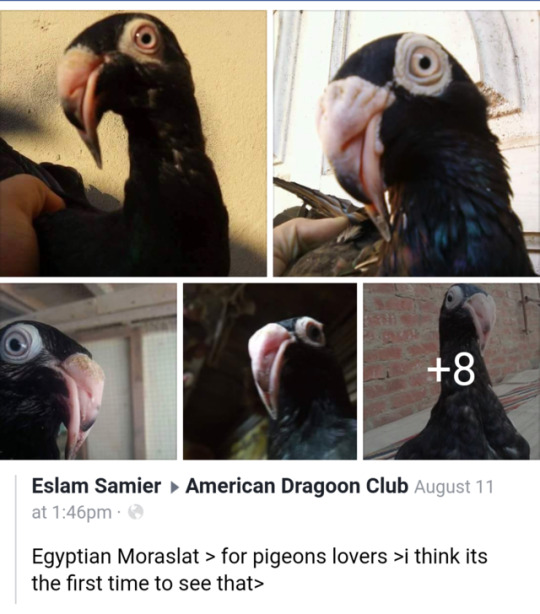
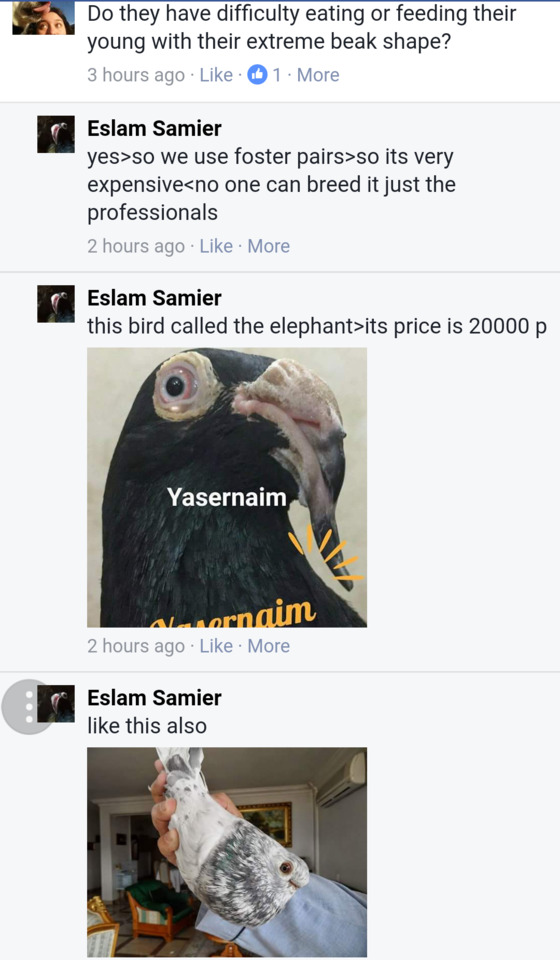
This is a very typical attitude among breeders of these birds with extreme body shapes.
I also have a series on weird, but physically sound breeds, and would be happy to go more into those in another ask.
512 notes
·
View notes